MG413 Data Insights Report: Tesco Plc's Data Usage in Retail Sector
VerifiedAdded on 2023/01/06
|9
|2772
|64
Report
AI Summary
This report provides a comprehensive analysis of data insights within the context of Tesco Plc and the retail industry. It begins by outlining the role of information and data in the retail sector, emphasizing its importance in customer relationship management and innovation. The report then details the types of data collected by Tesco, distinguishing between first, second, and third-party data sources, and explains how this data is used in day-to-day operations, including inventory management and personalized shopping experiences. Furthermore, it explores the information systems used by Tesco, such as DBMS, electronic spreadsheets, ERP, and GIS, and provides an example of how data drives business decision-making, specifically in the context of the Transferring Processing Process. Finally, the report describes how market research, both secondary and primary studies, is used in conjunction with MIS and other database systems to increase insight, providing a holistic view of data's impact on Tesco's strategic and operational activities.
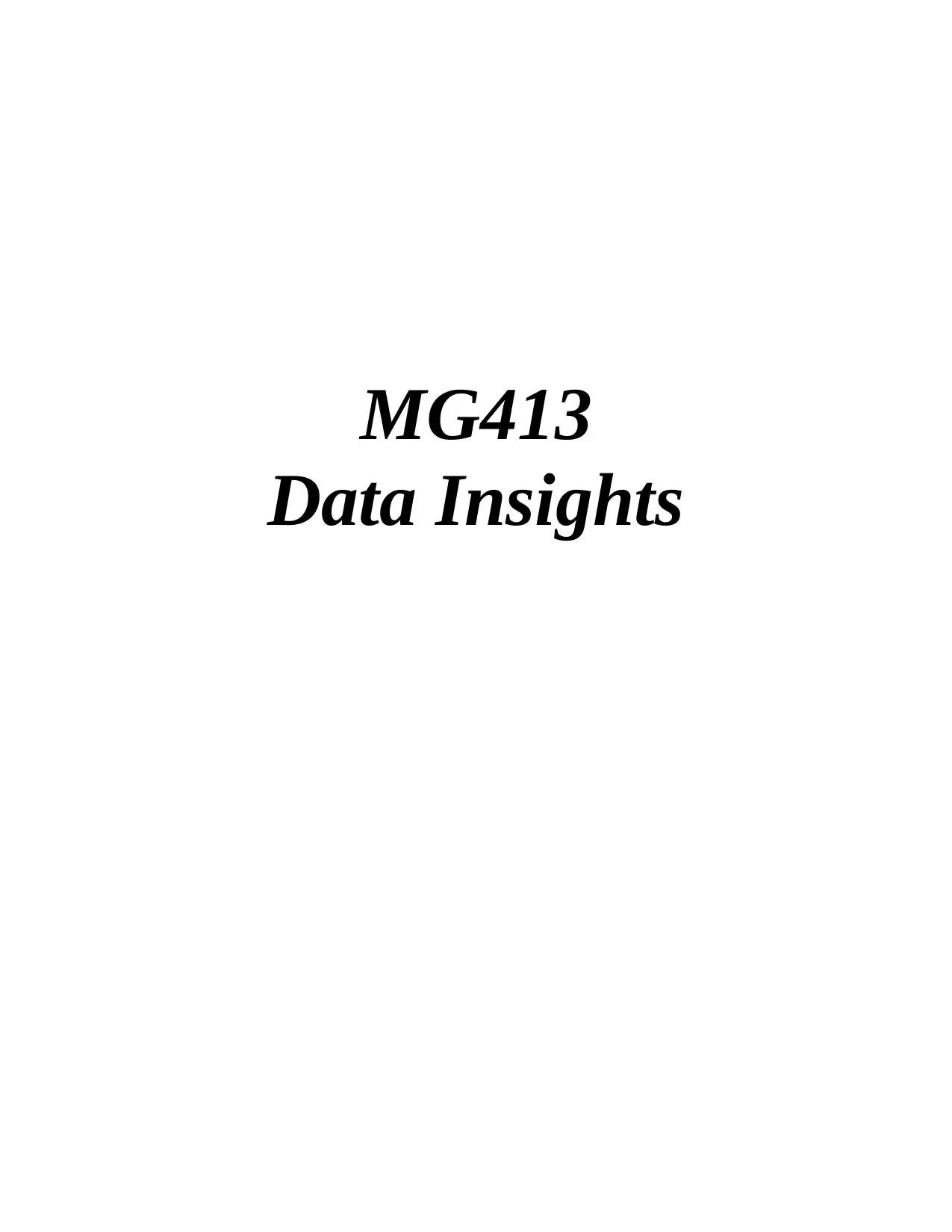
MG413
Data Insights
Data Insights
Paraphrase This Document
Need a fresh take? Get an instant paraphrase of this document with our AI Paraphraser
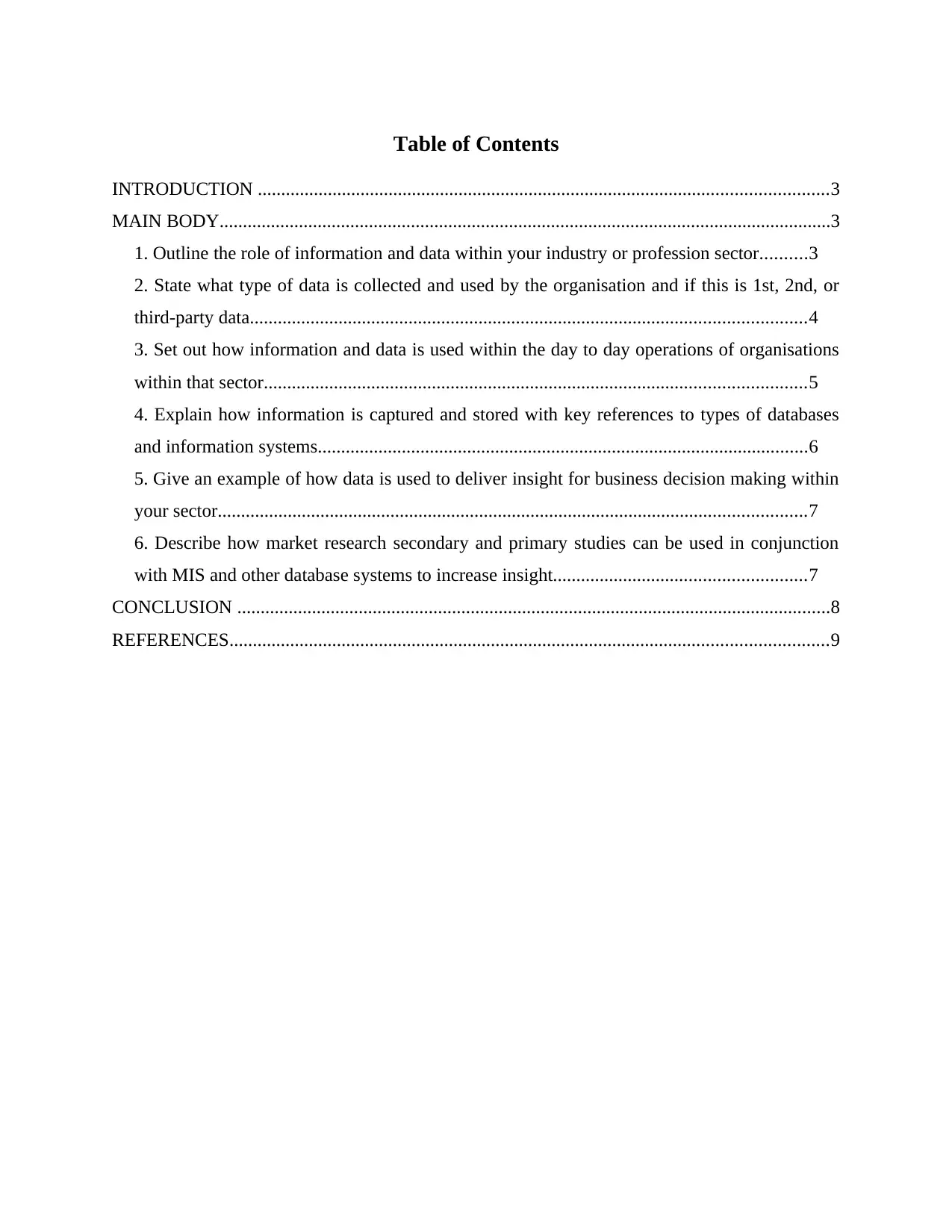
Table of Contents
INTRODUCTION ..........................................................................................................................3
MAIN BODY...................................................................................................................................3
1. Outline the role of information and data within your industry or profession sector..........3
2. State what type of data is collected and used by the organisation and if this is 1st, 2nd, or
third-party data.......................................................................................................................4
3. Set out how information and data is used within the day to day operations of organisations
within that sector....................................................................................................................5
4. Explain how information is captured and stored with key references to types of databases
and information systems.........................................................................................................6
5. Give an example of how data is used to deliver insight for business decision making within
your sector..............................................................................................................................7
6. Describe how market research secondary and primary studies can be used in conjunction
with MIS and other database systems to increase insight......................................................7
CONCLUSION ...............................................................................................................................8
REFERENCES................................................................................................................................9
INTRODUCTION ..........................................................................................................................3
MAIN BODY...................................................................................................................................3
1. Outline the role of information and data within your industry or profession sector..........3
2. State what type of data is collected and used by the organisation and if this is 1st, 2nd, or
third-party data.......................................................................................................................4
3. Set out how information and data is used within the day to day operations of organisations
within that sector....................................................................................................................5
4. Explain how information is captured and stored with key references to types of databases
and information systems.........................................................................................................6
5. Give an example of how data is used to deliver insight for business decision making within
your sector..............................................................................................................................7
6. Describe how market research secondary and primary studies can be used in conjunction
with MIS and other database systems to increase insight......................................................7
CONCLUSION ...............................................................................................................................8
REFERENCES................................................................................................................................9
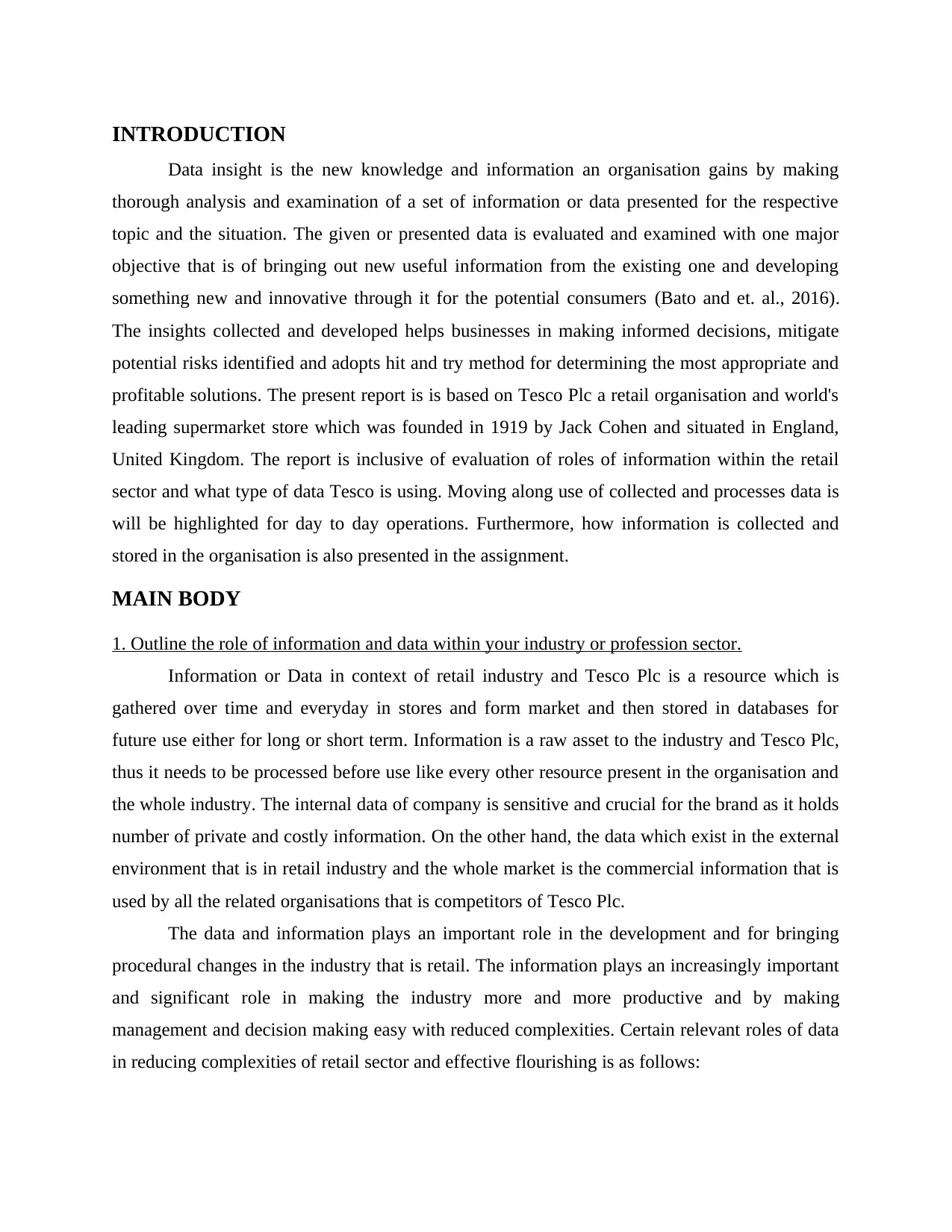
INTRODUCTION
Data insight is the new knowledge and information an organisation gains by making
thorough analysis and examination of a set of information or data presented for the respective
topic and the situation. The given or presented data is evaluated and examined with one major
objective that is of bringing out new useful information from the existing one and developing
something new and innovative through it for the potential consumers (Bato and et. al., 2016).
The insights collected and developed helps businesses in making informed decisions, mitigate
potential risks identified and adopts hit and try method for determining the most appropriate and
profitable solutions. The present report is is based on Tesco Plc a retail organisation and world's
leading supermarket store which was founded in 1919 by Jack Cohen and situated in England,
United Kingdom. The report is inclusive of evaluation of roles of information within the retail
sector and what type of data Tesco is using. Moving along use of collected and processes data is
will be highlighted for day to day operations. Furthermore, how information is collected and
stored in the organisation is also presented in the assignment.
MAIN BODY
1. Outline the role of information and data within your industry or profession sector.
Information or Data in context of retail industry and Tesco Plc is a resource which is
gathered over time and everyday in stores and form market and then stored in databases for
future use either for long or short term. Information is a raw asset to the industry and Tesco Plc,
thus it needs to be processed before use like every other resource present in the organisation and
the whole industry. The internal data of company is sensitive and crucial for the brand as it holds
number of private and costly information. On the other hand, the data which exist in the external
environment that is in retail industry and the whole market is the commercial information that is
used by all the related organisations that is competitors of Tesco Plc.
The data and information plays an important role in the development and for bringing
procedural changes in the industry that is retail. The information plays an increasingly important
and significant role in making the industry more and more productive and by making
management and decision making easy with reduced complexities. Certain relevant roles of data
in reducing complexities of retail sector and effective flourishing is as follows:
Data insight is the new knowledge and information an organisation gains by making
thorough analysis and examination of a set of information or data presented for the respective
topic and the situation. The given or presented data is evaluated and examined with one major
objective that is of bringing out new useful information from the existing one and developing
something new and innovative through it for the potential consumers (Bato and et. al., 2016).
The insights collected and developed helps businesses in making informed decisions, mitigate
potential risks identified and adopts hit and try method for determining the most appropriate and
profitable solutions. The present report is is based on Tesco Plc a retail organisation and world's
leading supermarket store which was founded in 1919 by Jack Cohen and situated in England,
United Kingdom. The report is inclusive of evaluation of roles of information within the retail
sector and what type of data Tesco is using. Moving along use of collected and processes data is
will be highlighted for day to day operations. Furthermore, how information is collected and
stored in the organisation is also presented in the assignment.
MAIN BODY
1. Outline the role of information and data within your industry or profession sector.
Information or Data in context of retail industry and Tesco Plc is a resource which is
gathered over time and everyday in stores and form market and then stored in databases for
future use either for long or short term. Information is a raw asset to the industry and Tesco Plc,
thus it needs to be processed before use like every other resource present in the organisation and
the whole industry. The internal data of company is sensitive and crucial for the brand as it holds
number of private and costly information. On the other hand, the data which exist in the external
environment that is in retail industry and the whole market is the commercial information that is
used by all the related organisations that is competitors of Tesco Plc.
The data and information plays an important role in the development and for bringing
procedural changes in the industry that is retail. The information plays an increasingly important
and significant role in making the industry more and more productive and by making
management and decision making easy with reduced complexities. Certain relevant roles of data
in reducing complexities of retail sector and effective flourishing is as follows:
⊘ This is a preview!⊘
Do you want full access?
Subscribe today to unlock all pages.

Trusted by 1+ million students worldwide

Customer Relationship Management- The key role which information play in retail
sector and for the organisation operating in it is developing and strengthening the
customer relationships. The retail is a major component of a potential supply chain and
bridges the gaps between the manufacturers and the end users of the goods. The data
flourishing in the industry enable the organisations to seek knowledge about the reactions
of customers related to varied types of goods and services the industry renders.
Innovate and Create- The information available in the retail sector also has huge
influence over innovation and creativity by which industry struck every now and then.
Basically, when retailers get hold of a new data and develops new knowledge, it
encourages them to develop and enhance their boundaries according to the social trends
and changing needs of buyers. This brings up fresh ideas and techniques in the industry
which leads its towards innovation and development according to the world and the
preferences of people (Donati and et. al., 2017).
2. State what type of data is collected and used by the organisation and if this is 1st, 2nd, or
third-party data.
Tesco Plc is a large, multinational and leading retail house of the United Kingdom that is
operating in market form several decades and is being expanding its boundaries since then. The
company was started as a small retail shop on the street and now it has turned into a huge
kingdom with enormous resources, operations and profitability. The information and data which
exist in the industry and within the organisation is a useful asset too. In recent years of modern
business environment and practices the data insights and knowledge gathered by the firms has
huge influence on company's decision making.
The data enables the firm in making evaluation of customers likes and dislikes which
assist the management in making appropriate inventory count present in the store and
warehouses. This saves huge cost and increases organisational profitability as the company is
providing customers with those good they need and desires to find in one place. The critical
aspect of the notion begins while collecting information and storing it. Data can be collected in
two ways either primary or secondary an Tesco Plc make use of both of the methods.
Primary- The primary data is a fresh information collected which did not exist in the
external environment and in the market and no one is familiar with it. This information is
generated and gathered form the first party directly (Zhou, Fu and Yang, 2016).
sector and for the organisation operating in it is developing and strengthening the
customer relationships. The retail is a major component of a potential supply chain and
bridges the gaps between the manufacturers and the end users of the goods. The data
flourishing in the industry enable the organisations to seek knowledge about the reactions
of customers related to varied types of goods and services the industry renders.
Innovate and Create- The information available in the retail sector also has huge
influence over innovation and creativity by which industry struck every now and then.
Basically, when retailers get hold of a new data and develops new knowledge, it
encourages them to develop and enhance their boundaries according to the social trends
and changing needs of buyers. This brings up fresh ideas and techniques in the industry
which leads its towards innovation and development according to the world and the
preferences of people (Donati and et. al., 2017).
2. State what type of data is collected and used by the organisation and if this is 1st, 2nd, or
third-party data.
Tesco Plc is a large, multinational and leading retail house of the United Kingdom that is
operating in market form several decades and is being expanding its boundaries since then. The
company was started as a small retail shop on the street and now it has turned into a huge
kingdom with enormous resources, operations and profitability. The information and data which
exist in the industry and within the organisation is a useful asset too. In recent years of modern
business environment and practices the data insights and knowledge gathered by the firms has
huge influence on company's decision making.
The data enables the firm in making evaluation of customers likes and dislikes which
assist the management in making appropriate inventory count present in the store and
warehouses. This saves huge cost and increases organisational profitability as the company is
providing customers with those good they need and desires to find in one place. The critical
aspect of the notion begins while collecting information and storing it. Data can be collected in
two ways either primary or secondary an Tesco Plc make use of both of the methods.
Primary- The primary data is a fresh information collected which did not exist in the
external environment and in the market and no one is familiar with it. This information is
generated and gathered form the first party directly (Zhou, Fu and Yang, 2016).
Paraphrase This Document
Need a fresh take? Get an instant paraphrase of this document with our AI Paraphraser
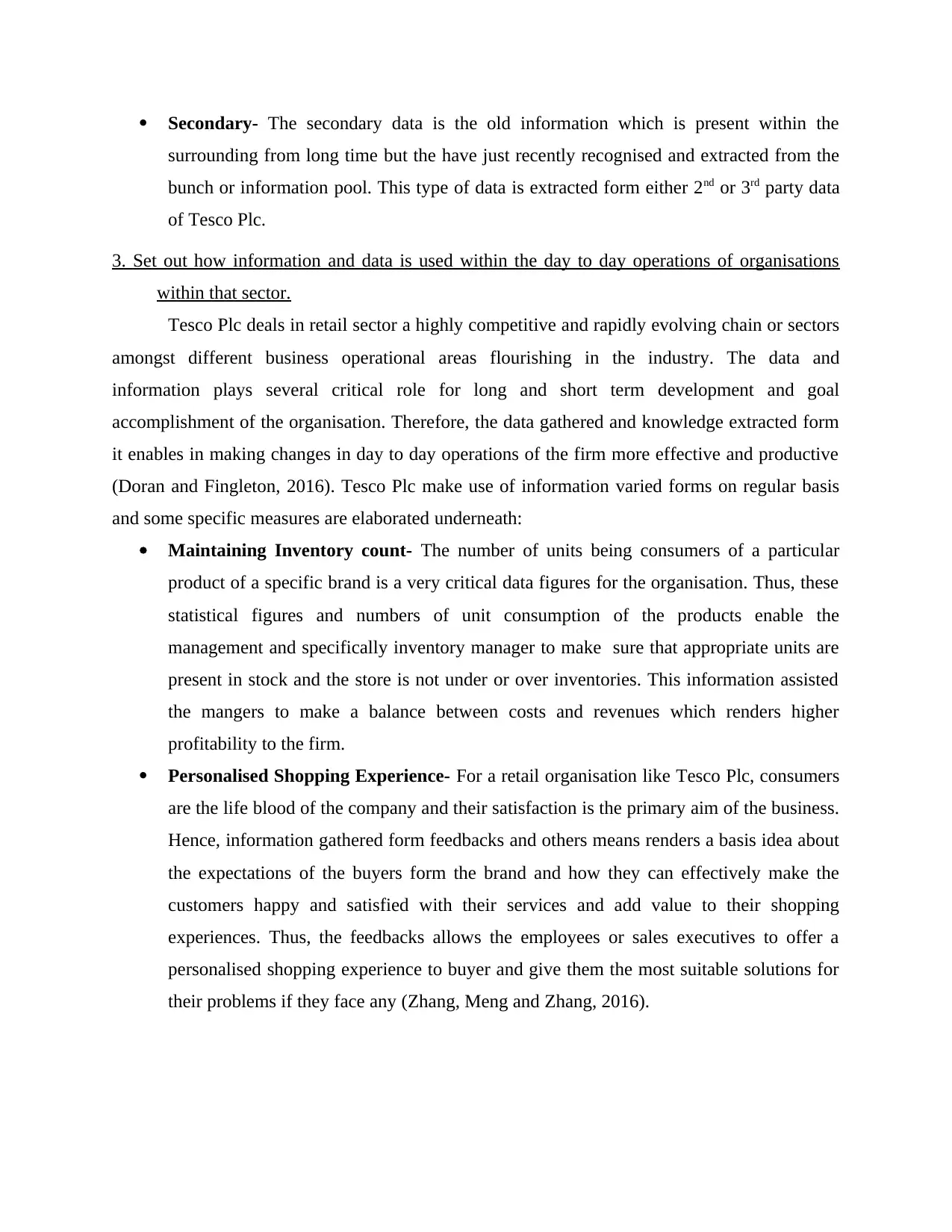
Secondary- The secondary data is the old information which is present within the
surrounding from long time but the have just recently recognised and extracted from the
bunch or information pool. This type of data is extracted form either 2nd or 3rd party data
of Tesco Plc.
3. Set out how information and data is used within the day to day operations of organisations
within that sector.
Tesco Plc deals in retail sector a highly competitive and rapidly evolving chain or sectors
amongst different business operational areas flourishing in the industry. The data and
information plays several critical role for long and short term development and goal
accomplishment of the organisation. Therefore, the data gathered and knowledge extracted form
it enables in making changes in day to day operations of the firm more effective and productive
(Doran and Fingleton, 2016). Tesco Plc make use of information varied forms on regular basis
and some specific measures are elaborated underneath:
Maintaining Inventory count- The number of units being consumers of a particular
product of a specific brand is a very critical data figures for the organisation. Thus, these
statistical figures and numbers of unit consumption of the products enable the
management and specifically inventory manager to make sure that appropriate units are
present in stock and the store is not under or over inventories. This information assisted
the mangers to make a balance between costs and revenues which renders higher
profitability to the firm.
Personalised Shopping Experience- For a retail organisation like Tesco Plc, consumers
are the life blood of the company and their satisfaction is the primary aim of the business.
Hence, information gathered form feedbacks and others means renders a basis idea about
the expectations of the buyers form the brand and how they can effectively make the
customers happy and satisfied with their services and add value to their shopping
experiences. Thus, the feedbacks allows the employees or sales executives to offer a
personalised shopping experience to buyer and give them the most suitable solutions for
their problems if they face any (Zhang, Meng and Zhang, 2016).
surrounding from long time but the have just recently recognised and extracted from the
bunch or information pool. This type of data is extracted form either 2nd or 3rd party data
of Tesco Plc.
3. Set out how information and data is used within the day to day operations of organisations
within that sector.
Tesco Plc deals in retail sector a highly competitive and rapidly evolving chain or sectors
amongst different business operational areas flourishing in the industry. The data and
information plays several critical role for long and short term development and goal
accomplishment of the organisation. Therefore, the data gathered and knowledge extracted form
it enables in making changes in day to day operations of the firm more effective and productive
(Doran and Fingleton, 2016). Tesco Plc make use of information varied forms on regular basis
and some specific measures are elaborated underneath:
Maintaining Inventory count- The number of units being consumers of a particular
product of a specific brand is a very critical data figures for the organisation. Thus, these
statistical figures and numbers of unit consumption of the products enable the
management and specifically inventory manager to make sure that appropriate units are
present in stock and the store is not under or over inventories. This information assisted
the mangers to make a balance between costs and revenues which renders higher
profitability to the firm.
Personalised Shopping Experience- For a retail organisation like Tesco Plc, consumers
are the life blood of the company and their satisfaction is the primary aim of the business.
Hence, information gathered form feedbacks and others means renders a basis idea about
the expectations of the buyers form the brand and how they can effectively make the
customers happy and satisfied with their services and add value to their shopping
experiences. Thus, the feedbacks allows the employees or sales executives to offer a
personalised shopping experience to buyer and give them the most suitable solutions for
their problems if they face any (Zhang, Meng and Zhang, 2016).

4. Explain how information is captured and stored with key references to types of databases and
information systems.
Information systems or databases is a organised and systematic collection of range of
data which is varied in nature form one another. The information systems are basically different
software applications that allow interactions with the user, the application and the database itself
for potentially capturing and analysing the collected information form varied sources and of
separate kinds. Tesco Plc is a digitally advanced firm which supports the modern technologies
and conveniently bring change within the operational practices by introducing updated
technologies and tools (Koltsidopoulos Papatzimos, Dawood and Thies, 2018).
There are some general information systems and some specialised information systems
which is used by Tesco Plc for supporting organisational processes. These different types of
systems are as follows:
Database Management System (DBMS)- This systems is a combination of software
and information that is particularly used by Tesco Plc to organise and examine the
procured data. It is a common system which can be used by other organisations as well
for storing and analysing their respective data belonging to any field. This is a general
type of information system that company uses.
Electronic Spreadsheet- This is another example of information system used by Tesco
Plc. It is based on formulas and considered as a basic system aimed at defining
relationships among the stored or filled information.
Enterprise Resource Planning (EPR)- It is the specialised system that is designed for
providing specific support to the process and carrying out concentrated analysis. ERP is
used for integrating the internal and external information management in whole
organisational operations (Weber and et. al., 2019).
Geographical Information System (GIS)- This is particularly helpful for Tesco Plc as
this system enable the company for managing and analysing all types of geographical
data. That helps Tesco Plc to develop synergy in their decisions for operations in wide
ranged locations and diverse markets.
information systems.
Information systems or databases is a organised and systematic collection of range of
data which is varied in nature form one another. The information systems are basically different
software applications that allow interactions with the user, the application and the database itself
for potentially capturing and analysing the collected information form varied sources and of
separate kinds. Tesco Plc is a digitally advanced firm which supports the modern technologies
and conveniently bring change within the operational practices by introducing updated
technologies and tools (Koltsidopoulos Papatzimos, Dawood and Thies, 2018).
There are some general information systems and some specialised information systems
which is used by Tesco Plc for supporting organisational processes. These different types of
systems are as follows:
Database Management System (DBMS)- This systems is a combination of software
and information that is particularly used by Tesco Plc to organise and examine the
procured data. It is a common system which can be used by other organisations as well
for storing and analysing their respective data belonging to any field. This is a general
type of information system that company uses.
Electronic Spreadsheet- This is another example of information system used by Tesco
Plc. It is based on formulas and considered as a basic system aimed at defining
relationships among the stored or filled information.
Enterprise Resource Planning (EPR)- It is the specialised system that is designed for
providing specific support to the process and carrying out concentrated analysis. ERP is
used for integrating the internal and external information management in whole
organisational operations (Weber and et. al., 2019).
Geographical Information System (GIS)- This is particularly helpful for Tesco Plc as
this system enable the company for managing and analysing all types of geographical
data. That helps Tesco Plc to develop synergy in their decisions for operations in wide
ranged locations and diverse markets.
⊘ This is a preview!⊘
Do you want full access?
Subscribe today to unlock all pages.

Trusted by 1+ million students worldwide
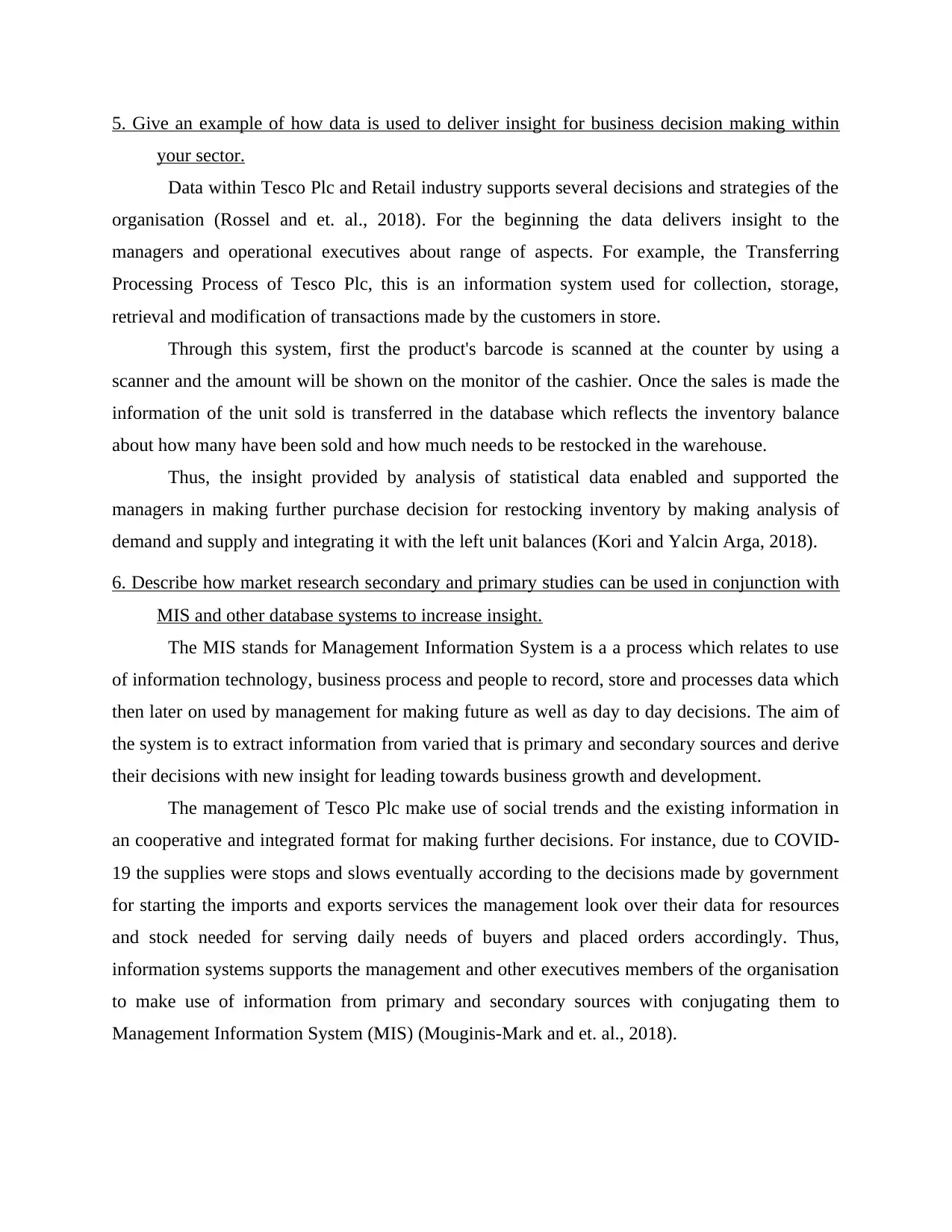
5. Give an example of how data is used to deliver insight for business decision making within
your sector.
Data within Tesco Plc and Retail industry supports several decisions and strategies of the
organisation (Rossel and et. al., 2018). For the beginning the data delivers insight to the
managers and operational executives about range of aspects. For example, the Transferring
Processing Process of Tesco Plc, this is an information system used for collection, storage,
retrieval and modification of transactions made by the customers in store.
Through this system, first the product's barcode is scanned at the counter by using a
scanner and the amount will be shown on the monitor of the cashier. Once the sales is made the
information of the unit sold is transferred in the database which reflects the inventory balance
about how many have been sold and how much needs to be restocked in the warehouse.
Thus, the insight provided by analysis of statistical data enabled and supported the
managers in making further purchase decision for restocking inventory by making analysis of
demand and supply and integrating it with the left unit balances (Kori and Yalcin Arga, 2018).
6. Describe how market research secondary and primary studies can be used in conjunction with
MIS and other database systems to increase insight.
The MIS stands for Management Information System is a a process which relates to use
of information technology, business process and people to record, store and processes data which
then later on used by management for making future as well as day to day decisions. The aim of
the system is to extract information from varied that is primary and secondary sources and derive
their decisions with new insight for leading towards business growth and development.
The management of Tesco Plc make use of social trends and the existing information in
an cooperative and integrated format for making further decisions. For instance, due to COVID-
19 the supplies were stops and slows eventually according to the decisions made by government
for starting the imports and exports services the management look over their data for resources
and stock needed for serving daily needs of buyers and placed orders accordingly. Thus,
information systems supports the management and other executives members of the organisation
to make use of information from primary and secondary sources with conjugating them to
Management Information System (MIS) (Mouginis‐Mark and et. al., 2018).
your sector.
Data within Tesco Plc and Retail industry supports several decisions and strategies of the
organisation (Rossel and et. al., 2018). For the beginning the data delivers insight to the
managers and operational executives about range of aspects. For example, the Transferring
Processing Process of Tesco Plc, this is an information system used for collection, storage,
retrieval and modification of transactions made by the customers in store.
Through this system, first the product's barcode is scanned at the counter by using a
scanner and the amount will be shown on the monitor of the cashier. Once the sales is made the
information of the unit sold is transferred in the database which reflects the inventory balance
about how many have been sold and how much needs to be restocked in the warehouse.
Thus, the insight provided by analysis of statistical data enabled and supported the
managers in making further purchase decision for restocking inventory by making analysis of
demand and supply and integrating it with the left unit balances (Kori and Yalcin Arga, 2018).
6. Describe how market research secondary and primary studies can be used in conjunction with
MIS and other database systems to increase insight.
The MIS stands for Management Information System is a a process which relates to use
of information technology, business process and people to record, store and processes data which
then later on used by management for making future as well as day to day decisions. The aim of
the system is to extract information from varied that is primary and secondary sources and derive
their decisions with new insight for leading towards business growth and development.
The management of Tesco Plc make use of social trends and the existing information in
an cooperative and integrated format for making further decisions. For instance, due to COVID-
19 the supplies were stops and slows eventually according to the decisions made by government
for starting the imports and exports services the management look over their data for resources
and stock needed for serving daily needs of buyers and placed orders accordingly. Thus,
information systems supports the management and other executives members of the organisation
to make use of information from primary and secondary sources with conjugating them to
Management Information System (MIS) (Mouginis‐Mark and et. al., 2018).
Paraphrase This Document
Need a fresh take? Get an instant paraphrase of this document with our AI Paraphraser
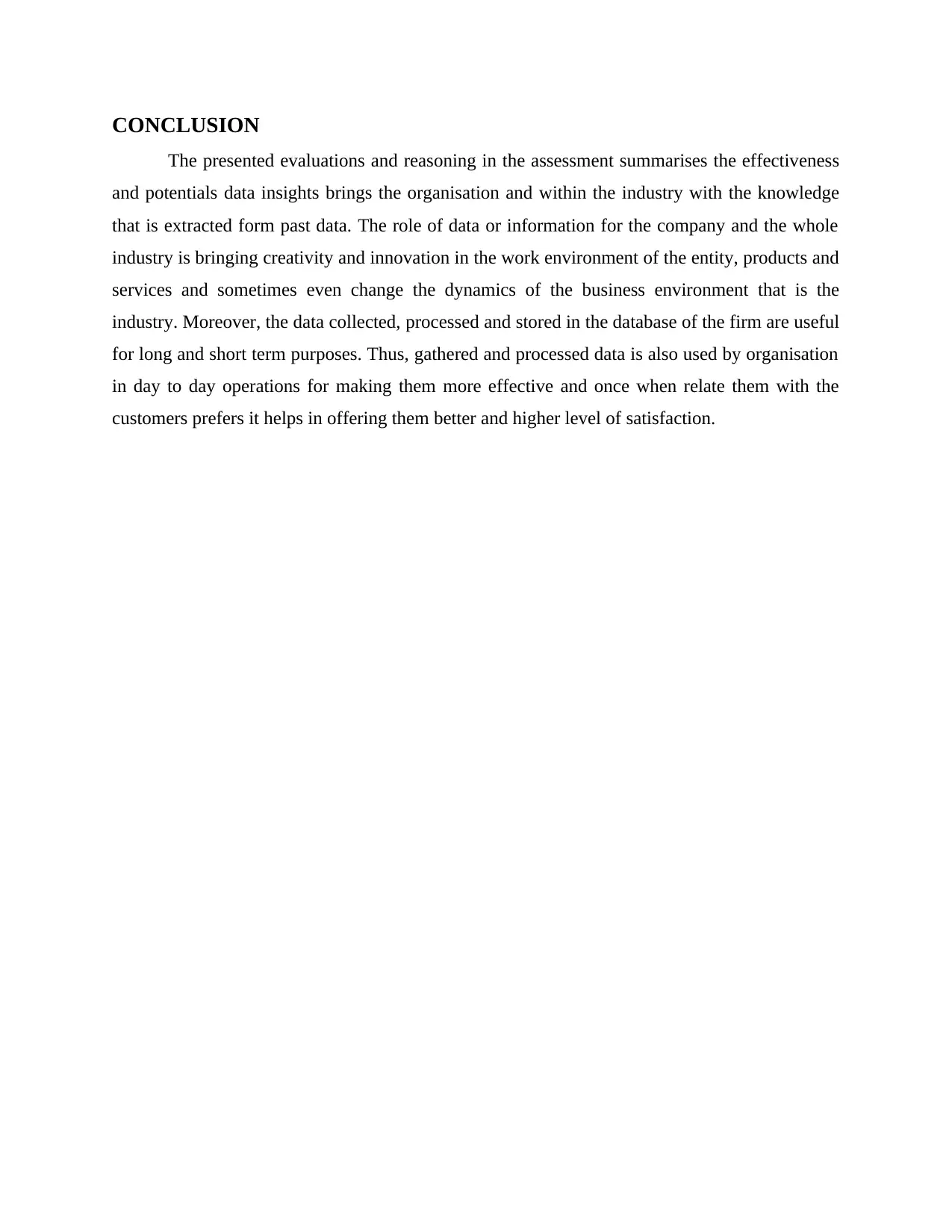
CONCLUSION
The presented evaluations and reasoning in the assessment summarises the effectiveness
and potentials data insights brings the organisation and within the industry with the knowledge
that is extracted form past data. The role of data or information for the company and the whole
industry is bringing creativity and innovation in the work environment of the entity, products and
services and sometimes even change the dynamics of the business environment that is the
industry. Moreover, the data collected, processed and stored in the database of the firm are useful
for long and short term purposes. Thus, gathered and processed data is also used by organisation
in day to day operations for making them more effective and once when relate them with the
customers prefers it helps in offering them better and higher level of satisfaction.
The presented evaluations and reasoning in the assessment summarises the effectiveness
and potentials data insights brings the organisation and within the industry with the knowledge
that is extracted form past data. The role of data or information for the company and the whole
industry is bringing creativity and innovation in the work environment of the entity, products and
services and sometimes even change the dynamics of the business environment that is the
industry. Moreover, the data collected, processed and stored in the database of the firm are useful
for long and short term purposes. Thus, gathered and processed data is also used by organisation
in day to day operations for making them more effective and once when relate them with the
customers prefers it helps in offering them better and higher level of satisfaction.
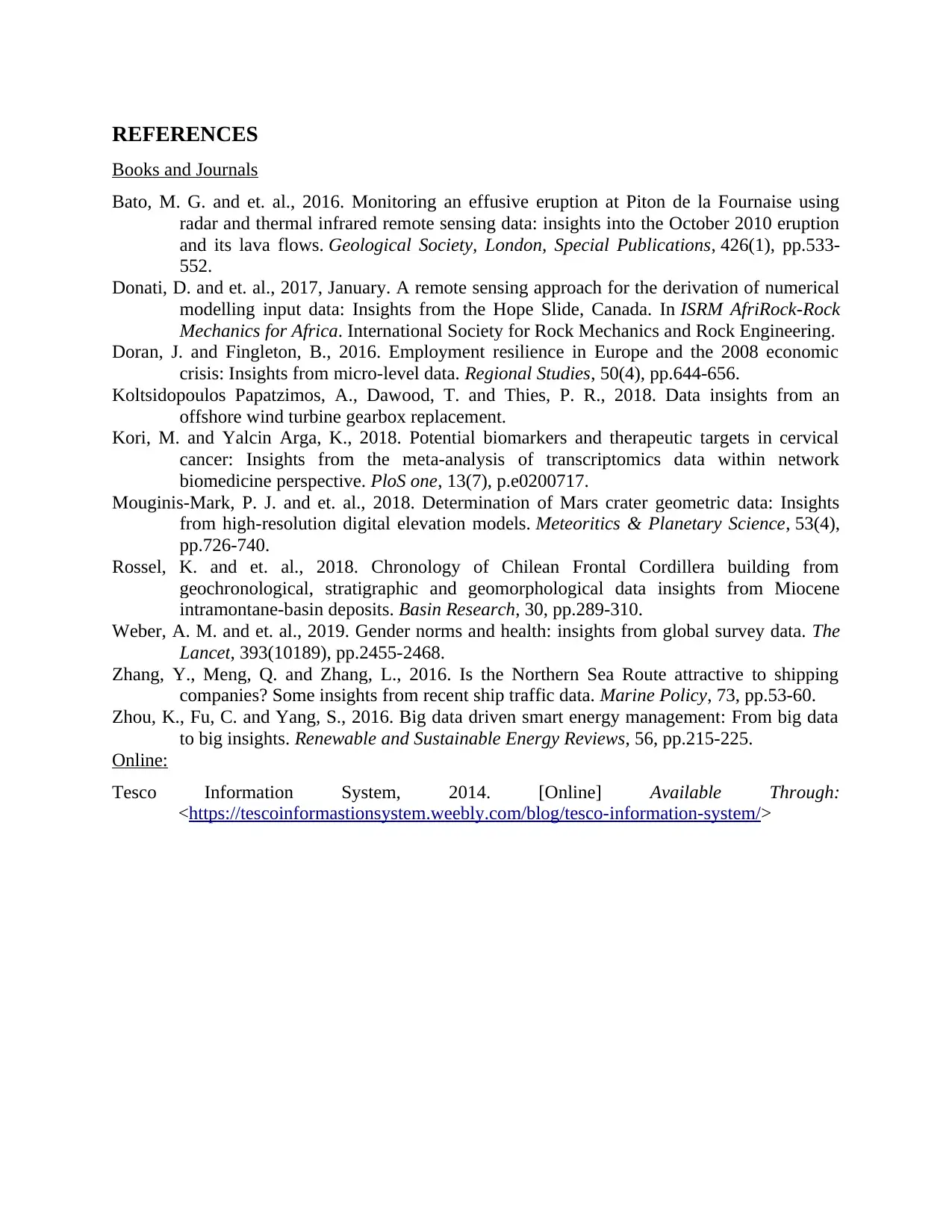
REFERENCES
Books and Journals
Bato, M. G. and et. al., 2016. Monitoring an effusive eruption at Piton de la Fournaise using
radar and thermal infrared remote sensing data: insights into the October 2010 eruption
and its lava flows. Geological Society, London, Special Publications, 426(1), pp.533-
552.
Donati, D. and et. al., 2017, January. A remote sensing approach for the derivation of numerical
modelling input data: Insights from the Hope Slide, Canada. In ISRM AfriRock-Rock
Mechanics for Africa. International Society for Rock Mechanics and Rock Engineering.
Doran, J. and Fingleton, B., 2016. Employment resilience in Europe and the 2008 economic
crisis: Insights from micro-level data. Regional Studies, 50(4), pp.644-656.
Koltsidopoulos Papatzimos, A., Dawood, T. and Thies, P. R., 2018. Data insights from an
offshore wind turbine gearbox replacement.
Kori, M. and Yalcin Arga, K., 2018. Potential biomarkers and therapeutic targets in cervical
cancer: Insights from the meta-analysis of transcriptomics data within network
biomedicine perspective. PloS one, 13(7), p.e0200717.
Mouginis‐Mark, P. J. and et. al., 2018. Determination of Mars crater geometric data: Insights
from high‐resolution digital elevation models. Meteoritics & Planetary Science, 53(4),
pp.726-740.
Rossel, K. and et. al., 2018. Chronology of Chilean Frontal Cordillera building from
geochronological, stratigraphic and geomorphological data insights from Miocene
intramontane‐basin deposits. Basin Research, 30, pp.289-310.
Weber, A. M. and et. al., 2019. Gender norms and health: insights from global survey data. The
Lancet, 393(10189), pp.2455-2468.
Zhang, Y., Meng, Q. and Zhang, L., 2016. Is the Northern Sea Route attractive to shipping
companies? Some insights from recent ship traffic data. Marine Policy, 73, pp.53-60.
Zhou, K., Fu, C. and Yang, S., 2016. Big data driven smart energy management: From big data
to big insights. Renewable and Sustainable Energy Reviews, 56, pp.215-225.
Online:
Tesco Information System, 2014. [Online] Available Through:
<https://tescoinformastionsystem.weebly.com/blog/tesco-information-system/>
Books and Journals
Bato, M. G. and et. al., 2016. Monitoring an effusive eruption at Piton de la Fournaise using
radar and thermal infrared remote sensing data: insights into the October 2010 eruption
and its lava flows. Geological Society, London, Special Publications, 426(1), pp.533-
552.
Donati, D. and et. al., 2017, January. A remote sensing approach for the derivation of numerical
modelling input data: Insights from the Hope Slide, Canada. In ISRM AfriRock-Rock
Mechanics for Africa. International Society for Rock Mechanics and Rock Engineering.
Doran, J. and Fingleton, B., 2016. Employment resilience in Europe and the 2008 economic
crisis: Insights from micro-level data. Regional Studies, 50(4), pp.644-656.
Koltsidopoulos Papatzimos, A., Dawood, T. and Thies, P. R., 2018. Data insights from an
offshore wind turbine gearbox replacement.
Kori, M. and Yalcin Arga, K., 2018. Potential biomarkers and therapeutic targets in cervical
cancer: Insights from the meta-analysis of transcriptomics data within network
biomedicine perspective. PloS one, 13(7), p.e0200717.
Mouginis‐Mark, P. J. and et. al., 2018. Determination of Mars crater geometric data: Insights
from high‐resolution digital elevation models. Meteoritics & Planetary Science, 53(4),
pp.726-740.
Rossel, K. and et. al., 2018. Chronology of Chilean Frontal Cordillera building from
geochronological, stratigraphic and geomorphological data insights from Miocene
intramontane‐basin deposits. Basin Research, 30, pp.289-310.
Weber, A. M. and et. al., 2019. Gender norms and health: insights from global survey data. The
Lancet, 393(10189), pp.2455-2468.
Zhang, Y., Meng, Q. and Zhang, L., 2016. Is the Northern Sea Route attractive to shipping
companies? Some insights from recent ship traffic data. Marine Policy, 73, pp.53-60.
Zhou, K., Fu, C. and Yang, S., 2016. Big data driven smart energy management: From big data
to big insights. Renewable and Sustainable Energy Reviews, 56, pp.215-225.
Online:
Tesco Information System, 2014. [Online] Available Through:
<https://tescoinformastionsystem.weebly.com/blog/tesco-information-system/>
⊘ This is a preview!⊘
Do you want full access?
Subscribe today to unlock all pages.

Trusted by 1+ million students worldwide
1 out of 9
Related Documents
Your All-in-One AI-Powered Toolkit for Academic Success.
+13062052269
info@desklib.com
Available 24*7 on WhatsApp / Email
![[object Object]](/_next/static/media/star-bottom.7253800d.svg)
Unlock your academic potential
Copyright © 2020–2025 A2Z Services. All Rights Reserved. Developed and managed by ZUCOL.




